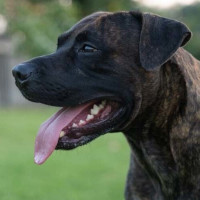Appearance of the Labrador Corso
|
| These athletic hybrid dogs will be born with the characteristics of each parent dog. This means there can be a variety of possible looks for the breed, as some dogs may resemble one parent more than the other. The Labrador Retriever is a solid dog with a broad muzzle and broad heads. These dogs have medium-sized hanging ears and kind eyes. Their chests are broad and reach down to the elbows, the front legs are straight, their backs are strong and the toplines are level. They have unique tails that are thick at the base and narrow as they approach the end. The tails are described as "otters" and have short hairs, giving them a rounded effect. This breed also has webbed feet, which is why they are so good at swimming. The muscular Italian Corso dog is a powerful dog with big bones and a thick body. Their heads are large and broad, with broad skulls and fairly prominent cheekbones. They have high-set ears that are sometimes cropped, in which case small triangles stand out. Their tails are sometimes docked. |
Temperament of the Labrador Corso
|
| This breed's personality is a blend of its parents' personalities. The Labrador Retriever is a loyal and affectionate dog. They are friendly dogs who get on well with everyone they meet. This breed loves its family and enjoys spending time with them. Labradors like to please and are easy to train, and are also excellent dogs for inexperienced owners. The other parent is a loyal companion who, if well-bred, will be affectionate and docile. They are good with children and excellent watchdogs. Naturally, Italian Corso dogs are dominant and possessive of their territory, especially around strangers. However, when properly trained, these dogs can be calm, obedient pets. These dogs are particularly protective of their owners, which can be a good thing, but also means they need to be very well trained to ensure they are safe pets. Their training shouldn't be too difficult, as they are very eager to please their owners. |
Needs and activities of the Labrador Corso
|
| The Labrador Corso is a cross between the Labrador Retriever and the Italian Corso dog. Since the Labrador Retriever is a big, energetic dog, it should live in a home with a large yard. These dogs like to exercise by going for long walks or jogging with their owners, and they also enjoy swimming. Italian Corso dogs also need regular exercise, but usually get enough energy by constantly patrolling the house and yard. Overall, they should benefit from 45 to 60 minutes of daily activity. |
Maintenance of the Labrador Corso
|
| The same rules apply to the care of these designer dogs, whose needs will fall somewhere between those of their parents. Labrador Retrievers shed a lot and need to be brushed regularly. They will also need frequent baths, as they have a doggy smell and like to play in the dirt outside. Italian Corso dogs are very low-maintenance when it comes to coat care, and brushing is only required occasionally. Other basic needs include teeth brushing, nail trimming and ear care. All dogs should have their teeth brushed every day if possible, or at least two or three times a week. Some dogs need their nails trimmed more often than others, but in general they should be checked once or twice a month. As for ear cleaning, your dog's ears should be wiped every week to prevent ear infections. |









 English (United Kingdom)
English (United Kingdom)